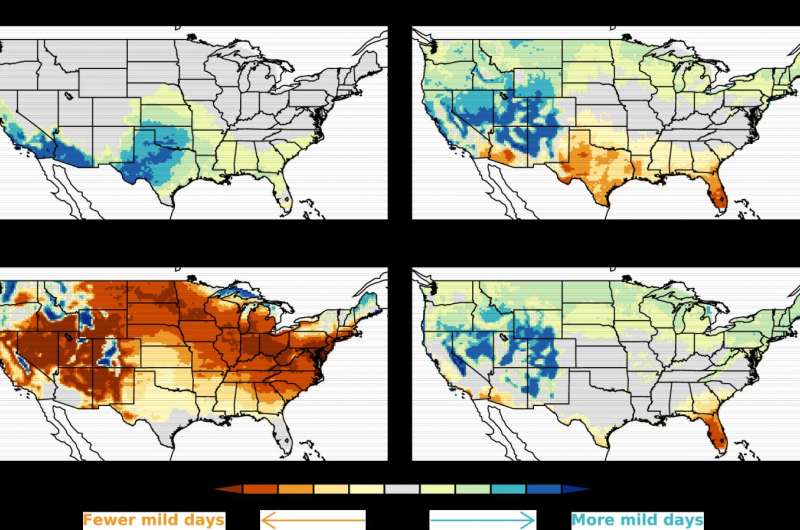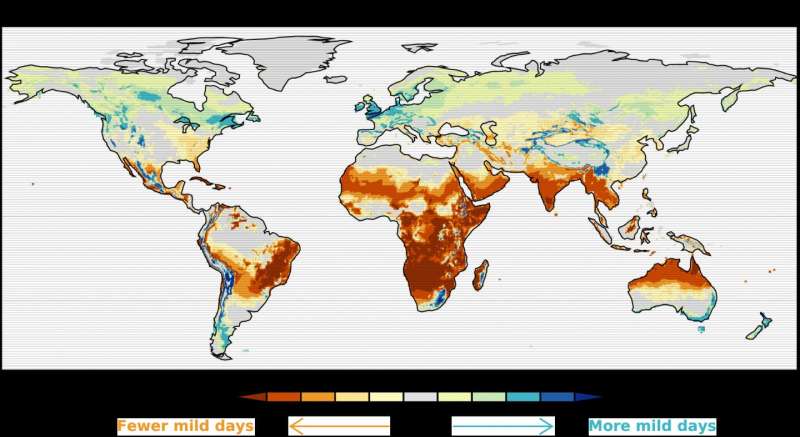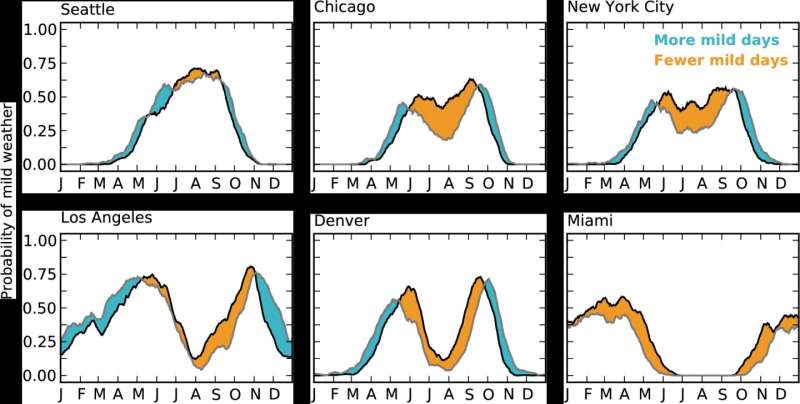Climate change to shift global pattern of mild weather

As scientists work to predict how climate change may affect hurricanes, droughts, floods, blizzards and other severe weather, there's one area that's been overlooked: mild weather. But no more.
NOAA and Princeton University scientists have produced the first global analysis of how climate change may affect the frequency and location of mild weather - days that are perfect for an outdoor wedding, baseball, fishing, boating, hiking or a picnic. Scientists defined "mild" weather as temperatures between 64 and 86 degrees F, with less than a half inch of rain and dew points below 68 degrees F, indicative of low humidity.
Knowing the general pattern for mild weather over the next decades is also economically valuable to a wide range of businesses and industries. Travel, tourism, construction, transportation, agriculture, and outdoor recreation all benefit from factoring weather patterns into their plans.
Tropics to lose milder days
The new research, published in the journal Climatic Change, projects that globally the number of mild days will decrease by 10 or 13 percent by the end of the century because of climate warming from the buildup of human-caused greenhouse gases in the atmosphere. The current global average of 74 mild days a year will drop by four days by 2035 and 10 days by 2081 to 2100. But this global average decrease masks more dramatic decreases in store for some areas and increases in mild days in other regions.

"Extreme weather is difficult to relate to because it may happen only once in your lifetime," said first author Karin van der Wiel, a Princeton postdoctoral researcher at NOAA's Geophysical Fluid Dynamics Laboratory (GFDL) located on the university's Forrestal Campus. "We took a different approach here and studied a positive meteorological concept, weather that occurs regularly, and that's easier to relate to."
Scientists predict the largest decreases in mild weather will happen in tropical regions because of rising heat and humidity. The hardest-hit areas are expected to be in Africa, Asia and Latin America, where some regions could see 15 to 50 fewer days of mild weather a year by the end of the century. These are also areas where NOAA and partner research shows economic damages due to climate change. The loss of mild weather days, especially during summer, when they can serve to break up extended heatwaves, also could significantly affect public health.
U.S., Canada, northern Europe to gain milder days
People living in the mid-latitudes, which include much of the United States, as well as many mountainous areas around the world, will gain mild weather days on average, the new study found. The biggest winners will include communities along the border with Canada in the Northeast, Midwest and Northwest, as well as many parts of Canada.

Other areas projected to gain as much as 10 to 15 days more annually of mild weather by the end of the 21st century include parts of England and northern Europe, and Patagonia in extreme southern South America. In some of these areas, mild weather will drop during increasingly hot and humid summers but become more plentiful in fall, winter and spring as winters warm and the shoulder seasons last longer.
"We believe improving the public understanding of how climate change will affect something as important as mild weather is an area ripe for more research and more focused studies," said Sarah Kapnick, a physical scientist at NOAA's GFDL and co-author. "Predicting changes in mild weather is not only important to business and industry, but can also contribute to research on the future of physical and mental health, leisure and urban planning."
Scientists used high-resolution climate models to investigate the changing patterns of mild weather globally by examining the effect over time of increased warming from the buildup of greenhouse gas emissions in the atmosphere. The work was made possible by decades of Earth system and model development at NOAA's GFDL and by improvements made to NOAA's research supercomputing capability, including access to two high performance supercomputers, Gaea and Theia, named after figures in Greek mythology.
More information: Derek Lemoine et al. A top-down approach to projecting market impacts of climate change, Nature Climate Change (2015). DOI: 10.1038/nclimate2759
Journal information: Nature Climate Change , Climatic Change
Provided by NOAA Headquarters




















